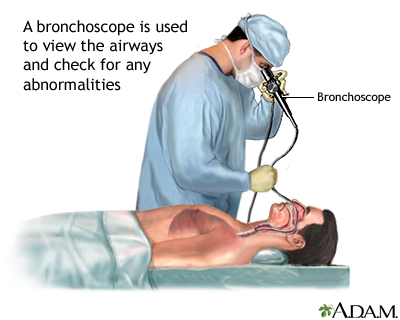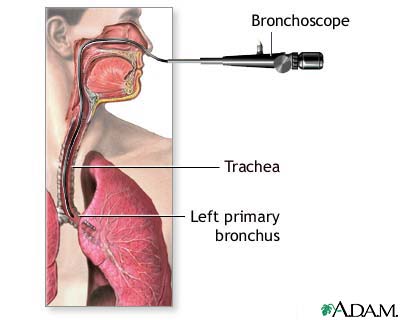Health Library
Bronchoscopy
Fiberoptic bronchoscopy; Lung cancer - bronchoscopy; Pneumonia - bronchoscopy; Chronic lung disease - bronchoscopy
Bronchoscopy is a test to view the airways and diagnose lung disease. It may also be used during the treatment of some lung conditions.
Images


I Would Like to Learn About:
How the Test is Performed
A bronchoscope is a device used to see the inside of the airways and lungs. The scope can be flexible or rigid. A flexible scope is almost always used. It is a tube less than one half inch (1 centimeter) wide and about 2 feet (60 centimeters) long. In rare cases, a rigid bronchoscope is used.
- You will likely get medicines through a vein (IV, or intravenously) to help you relax. Or, you may be asleep under general anesthesia, especially if a rigid scope is used.
- A numbing drug (anesthetic) will be sprayed in your mouth and throat. If bronchoscopy is done through your nose, numbing jelly will be placed in the nostril the tube goes through.
- The scope is gently inserted. It will likely make you cough at first. The coughing will stop as the numbing drug begins to work.
- Your health care provider may send saline solution through the tube. This washes the lungs and allows your provider to collect samples of lung cells, fluids, microbes and other materials inside the air sacs. This part of the procedure is called a lavage.
- Sometimes, tiny brushes, needles, or forceps may be passed through the bronchoscope to take very small tissue samples (biopsies) from your lungs.
- Your provider can also place a stent in your airway or view your lungs with ultrasound during the procedure. A stent is a small tube-like medical device. Ultrasound is a painless imaging method that allows your provider to see inside your body.
- Sometimes ultrasound is used to see the lymph nodes and tissues around your airways, and small needles can be inserted there to obtain tissue and make certain diagnoses.
- At the end of the procedure, the scope is removed.
How to Prepare for the Test
Follow instructions on how to prepare for the test. You will likely be told:
- Not to eat or drink anything for 6 to 12 hours before your test.
- Not to take aspirin, ibuprofen, or other blood-thinning drugs before your procedure. Ask the provider who will do your bronchoscopy if and when to stop taking these drugs.
- Arrange for a ride to and from the hospital.
- Arrange for help with work, child care, or other tasks, as you will likely need to rest the next day.
The test is most often done as an outpatient procedure, and you will go home the same day. Rarely, some people may need to stay overnight in the hospital.
How the Test will Feel
Local anesthetic is used to relax and numb your throat muscles. Until this medicine begins to work, you may feel fluid running down the back of your throat. This may cause you to cough or gag.
Once the medicine takes effect, you may feel pressure or mild tugging as the tube moves through your windpipe. Although you may feel like you are not able to breathe when the tube is in your throat, there is no risk of this happening. The medicines you receive to relax will help with these symptoms. You will likely forget most of the procedure.
When the anesthetic wears off, your throat may be scratchy for several days. After the test, your ability to cough (cough reflex) will return in 1 to 2 hours. You will not be allowed to eat or drink until your cough reflex returns.
Why the Test is Performed
You may have a bronchoscopy to help your provider diagnose lung problems. Your provider will be able to inspect your airways or take a biopsy sample.
Common reasons to do a bronchoscopy for diagnosis are:
- An imaging test showed abnormal changes of your lung, such as a growth or tumor, changes or scarring of lung tissue, or collapse of one area of your lung.
- To biopsy lymph nodes near your lungs.
- To see why you are coughing up blood.
- To explain shortness of breath or low oxygen levels.
- To see if there is a foreign object in your airway.
- You have a cough that has lasted more than 3 months without any clear cause.
- You have an infection in your lungs and major airways (bronchi) that cannot be diagnosed any other way or need a certain type of diagnosis.
- You inhaled a toxic gas or chemical.
- To see if a lung rejection after a lung transplant is occurring.
You may also have a bronchoscopy to treat a lung or airway problem. For example, it may be done to:
- Remove fluid or mucus plugs from your airways
- Remove a foreign object from your airways
- Widen (dilate) an airway that is blocked or narrowed
- Drain an abscess
- Treat cancer using a number of different techniques
- Wash out an airway
Normal Results
Normal results mean normal cells and fluids are found. No foreign substances or blockages are seen.
What Abnormal Results Mean
Many disorders can be diagnosed with bronchoscopy, including:
- Infections from bacteria, viruses, fungi, parasites, or tuberculosis.
- Lung damage related to allergic-type reactions.
- Lung disorders in which the deep lung tissues become inflamed due to the immune system response, and then damaged. For example, changes from sarcoidosis or rheumatoid arthritis may be found.
- Lung cancer, or cancer in the area between the lungs.
- Narrowing (stenosis) of the trachea or bronchi.
- Acute rejection or infection after a lung transplant.
Risks
Main risks of bronchoscopy are:
- Bleeding from biopsy sites (most dangerous complication in very rare occasions)
- Infection
There is also a small risk for:
- Abnormal heart rhythms
- Breathing difficulties
- Fever
- Heart attack, in people with existing heart disease
- Low blood oxygen
- Collapsed lung
- Sore throat
Risks when general anesthesia is used include:
- Muscle pain
- Change in blood pressure
- Slower heart rate
- Nausea and vomiting
Related Information
Lung cancer - small cellSimple pulmonary eosinophilia
Aspiration pneumonia
Atelectasis
CMV pneumonia
Cryptococcosis
Disseminated tuberculosis
Lung metastases
Pneumonia - weakened immune system
References
Christie NA. Operative otolaryngology: bronchoscopy. In: Myers EN, Snyderman CH, eds. Operative Otolaryngology Head and Neck Surgery. 3rd ed. Philadelphia, PA: Elsevier; 2018:chap 18.
Kupeli E, Mehta AC. Diagnostic bronchoscopy. In: Broaddus VC, Ernst JD, King TE, et al, eds. Murray and Nadel's Textbook of Respiratory Medicine. 6th ed. Philadelphia, PA: Elsevier; 2022:chap 26.
Weinberger SE, Cockrill BA, Mandel J. Evaluation of the patient with pulmonary disease. In: Weinberger SE, Cockrill BA, Mandel J, eds. Principles of Pulmonary Medicine. 7th ed. Philadelphia, PA: Elsevier; 2019:chap 3.
BACK TO TOPReview Date: 1/20/2022
Reviewed By: Denis Hadjiliadis, MD, MHS, Paul F. Harron, Jr. Associate Professor of Medicine, Pulmonary, Allergy, and Critical Care, Perelman School of Medicine, University of Pennsylvania, Philadelphia, PA. Also reviewed by David Zieve, MD, MHA, Medical Director, Brenda Conaway, Editorial Director, and the A.D.A.M. Editorial team.
 | A.D.A.M., Inc. is accredited by URAC, for Health Content Provider (www.urac.org). URAC's accreditation program is an independent audit to verify that A.D.A.M. follows rigorous standards of quality and accountability. A.D.A.M. is among the first to achieve this important distinction for online health information and services. Learn more about A.D.A.M.'s editorial policy, editorial process and privacy policy. A.D.A.M. is also a founding member of Hi-Ethics. This site complies with the HONcode standard for trustworthy health information: verify here. |
The information provided herein should not be used during any medical emergency or for the diagnosis or treatment of any medical condition. A licensed medical professional should be consulted for diagnosis and treatment of any and all medical conditions. Links to other sites are provided for information only -- they do not constitute endorsements of those other sites. © 1997- 2022 A.D.A.M., a business unit of Ebix, Inc. Any duplication or distribution of the information contained herein is strictly prohibited.
